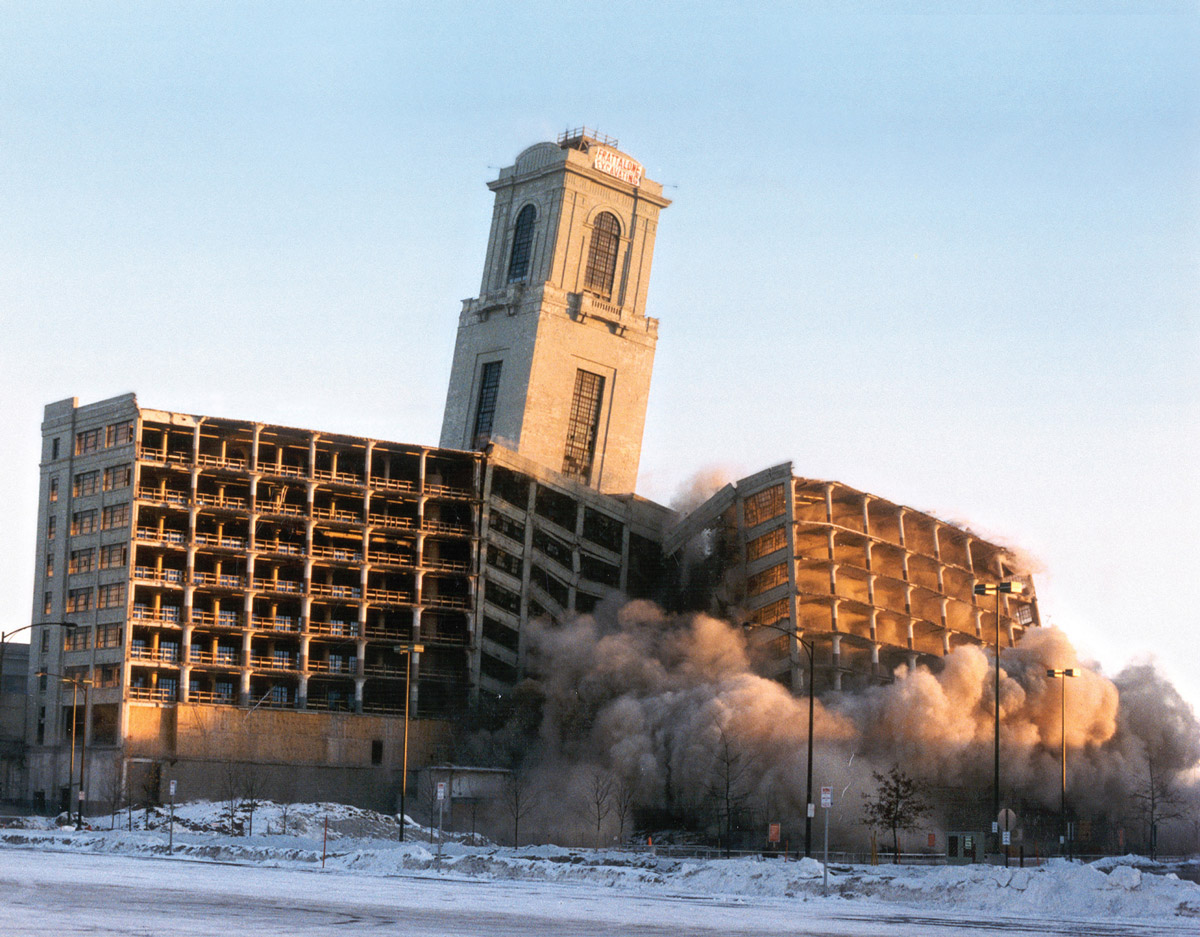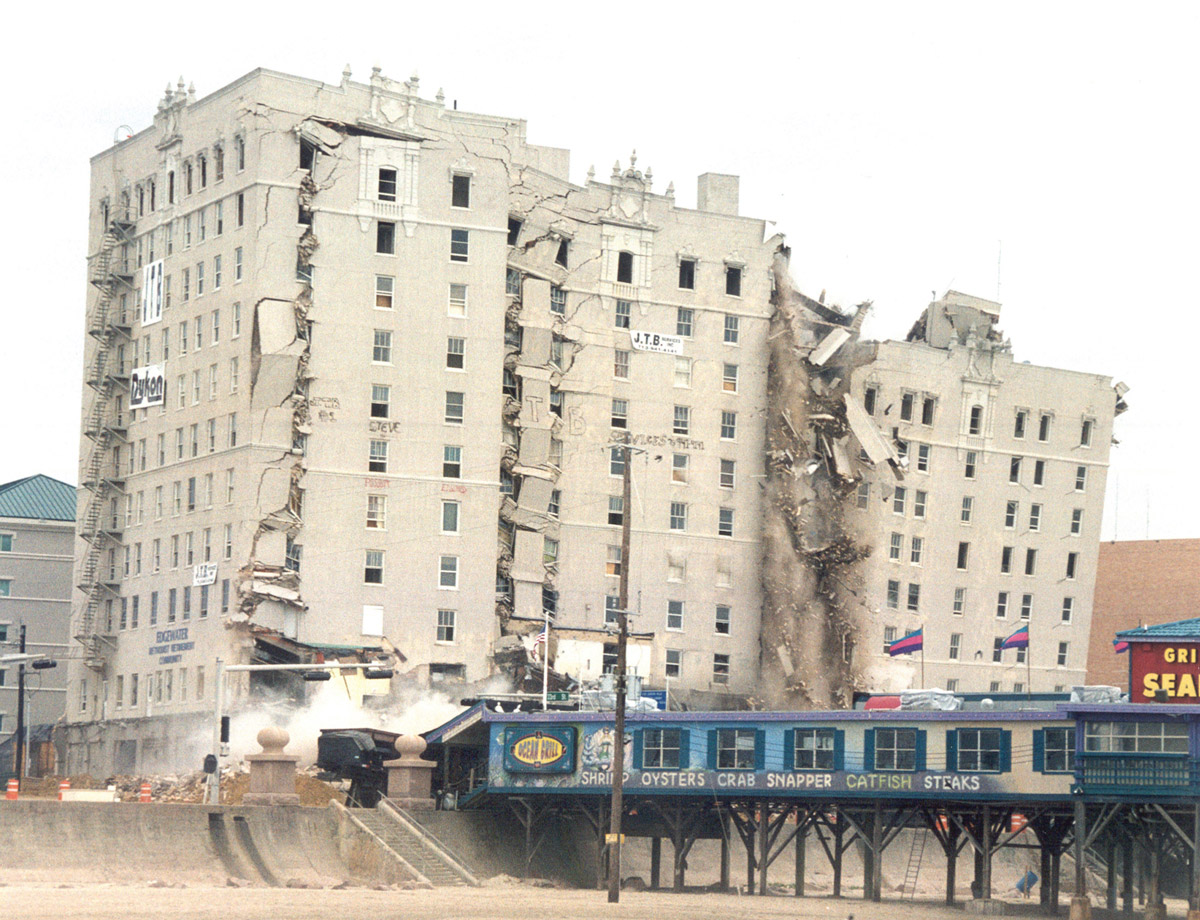Terrain Vague
The sublime art of demolition
Jeff Byles
I hear the ruin of all space, shattered glass and toppling masonry, and time one livid final flame. What’s left us then?
—James Joyce, Ulysses
Smuggled in between clips of a severed, plunging drawbridge and a couple of hulking natural gas tanks being crumpled like tin cans, these are perhaps not the most bankable few frames from The Art of Demolition, an in-house curriculum vitae produced by the Loizeaux family of Phoenix, Maryland, one of the world’s foremost explosive demolition teams.[1] Yet that bolt of smokestackian sublimity carries the shock of a manifesto. As the dynamite and detonating cord play out their occult magic, what you’re seeing is the unspooling of space. Stop. Rewind. Pause. Caught in mid-tumble, the death of a smokestack provokes a seductive encounter with the superreal. “At last each particle of space is meaningful,” as Louis Aragon wrote in another lifetime, “like a syllable of some dismantled word.”[2] Demolition, too, has its metaphysic, as the profession’s sage practitioners are wont to point out. Mark Loizeaux, the structural savant who helped fell Seattle’s massive Kingdome stadium in 2000, put it this way: “I just looked at it and asked myself, ‘What does the Kingdome want to do?,’” he said, explaining how he’d turn the world’s largest concrete dome to a heap of rubble in just seventeen seconds. “Basically, it’s gravity, the power of the planet that brings the structure back to grade,” he added. “The Kingdome is coming down. It wants to come down.”[3] It’s wanted to do that, he told reporters, since the day it was built.
With demolition, of course, you’re always headed back to earth, where metaphysical niceties are sometimes trampled by the industry’s pragmatists. “A lot of people would like to preserve every damn building where Millard Fillmore ever used the public convenience,” George F. McDonnell, a consultant for a large demolition company, said with refreshing candor in 1975. “There’s a lot of sentimental drivel about all that,” he added, calling it a blemish on the national heritage to go blubbering on about buildings and institutions and laws that had grown bowlegged with age. “When they don’t work anymore, they should be dismantled and the parts recycled,” he railed. “Let the wrecking ball swing!”[4]
Demolition, in short, is everywhere about us. Yet beyond the shrill (if worthy) historic-preservationist rallying cries over this threatened monument or that lost masterpiece, surprisingly little comment has been made about the psycho-spatial impact of our wrecked ghost towns. When that which goes up inevitably comes down—via backhoes and pickaxes, or high-velocity charges and TNT—it leaves in its wake, I want to argue, a special sort of aura. Amid the toppling bricks and blinding dust, a new creative-destructive dialectic is born. The demolitionist credo: Tearing buildings down gives forth; building up taketh away. “Architecture, we forget at our peril, is inherently violent,” explains critic Herbert Muschamp. “It invariably subtracts from the range of available possibilities, especially the perennially attractive option of building nothing at all.”[8] Demolition, that is to say, is a profoundly generative act. Its gift of immateriality trumps all.

There, between a mechanical sawmill and a button works, was a strip of meadow still remaining, with patches of scorched yellow grass; a goat, tied to a post, walked round in circles bleating; further on a dead tree crumbled in the hot sun. … In the sky, a flock of white clouds swam past as slowly as a swan. In the corner of the field, the goat had turned in their direction and looked at them; from time to time, at regular intervals, it bleated softly. And holding hands, their eyes brimming with tenderness, they looked into the distance, lost in thought, on the pallid slopes of Montmartre, surrounded by the great forest of factory chimneys blocking out the horizon, in that chalky and desolate banlieue, where the green trees shading the cheap taverns moved them to the edge of tears.[10]
This moment gets us very close to our smokestackian sublime. Here the chimneys are still standing, yet the play between chimney and not-chimney, between the urban industrial skyline and this incomparable strip of meadow, speaks to the flood of meanings in suddenly liberated spaces. Here we have arrived at what Anthony Vidler calls “the hermeneutics of absence.”[11] We’re blinking back tears at these plots piled high with toppled masonry and wracked steel. We’re scheming to unlock the promise of this great meltingness—so much like the tenderly devastating bleat of that solitary goat.

A storm blowing from Paradise: that is what washes over our vague terrains—our moments of sudden insight as architecture is hurled at our feet—and blasts them with arcs of lightning. As Benjamin elsewhere hinted, demolitionists are “destructive characters” par excellence, rustlers who alight on these terrains to be our rough-and-ready guides to the immaterial future. “The destructive character sees nothing permanent,” he writes. “But for this very reason he sees ways everywhere. Where others encounter walls or mountains, there, too, he sees a way.” This, Benjamin continues, constitutes a radical sort of freedom. “Because he sees ways everywhere, he always stands at a crossroads. No moment can know what the next will bring. What exists he reduces to rubble—not for the sake of the rubble, but for that of the way leading through it.”[30]
These ways are but vectors toward the “hermeneutics of absence.” The demolitionist sketches them out, dropping a stack here, a bridge there, then moves on to liberate the next patch of ground. It may take us some time to decipher these ways. After all, Benjamin’s great project—all those fences and doorknobs and vistas and monuments—was left unfinished at his death. Stop. Rewind. Play. As Salman Rushdie recently put it, you’ve gotta be ready for anything: “I mean, the world is not a naturalistic place. Buildings may fall down. The world is not like kitchen-sink drama; the world is this weird, operatic place.”[31] It’s what Benjamin called now-time, the world of sudden, shocking illuminations, in which the true image of the past flits by. This true image is what we briefly descry in the fatal falling of a tower.
- Controlled Demolition Inc. 2002 Implosion Montage: Art of Demolition. Videotape provided to the author by CDI.
- Louis Aragon, Paris Peasant, trans. Simon Watson Taylor (Boston: Exact Change, 1994), p. 169.
- Jim Lynch, “Landmark’s Rise and Fall,” The Oregonian, 23 March 2000.
- Demolition Age, April/May 1975, p. 18.
- Christopher Reynolds, “Out With the Old: In L.A., There’s More ‘Erase-atecture’ Than Preservation,” The Los Angeles Times, 29 December 2002.
- Ibid.
- Michael Powell, “Knock-Down, Drag-Out Urban Renewal,” The Washington Post, 14 March 2003.
- Herbert Muschamp, “A Handsome Hunk Of a Glass Tower,” The New York Times, 2 June 2002.
- Ignasi de Solà-Morales Rubio, quoted at groupe-e2.com/e2-vague.htm [link defunct—Eds.]. Accessed 30 July 2012.
- Quoted in T. J. Clark, The Painting of Modern Life (Princeton, NJ: Princeton University Press, 1984), p. 28.
- See Anthony Vidler, The Architectural Uncanny (Cambridge, MA: MIT Press, 1992).
- Le Corbusier, The City of Tomorrow and its Planning, trans. Frederick Etchells (New York: Dover, 1987), p. 281.
- Quoted in Walter Benjamin, The Arcades Project, ed. Rolf Tiedemann, trans. Howard Eiland and Kevin McLaughlin (Cambridge, MA: Belknap Press of Harvard University Press, 1999), p. 12.
- Clark, The Painting of Modern Life, p. 37.
- Quoted in Benjamin, Arcades Project, p. 133.
- “Farewell to Penn Station,” The New York Times, 30 October 1963.
- The Destruction of Penn Station: Photographs by Peter Moore, ed. Barbara Moore (New York: D.A.P., 2000), p. 27.
- Charles Jencks, The Language of Post-Modern Architecture (New York: Rizzoli, 1977), p. 9.
- “The Case History of a Failure,” Architectural Forum, December 1965, p. 24.
- Tom Yarbrough, “Expert’s Aim: Bring Pruitt-Igoe To Knees,” St. Louis Post-Dispatch, 24 February 1972.
- Andreas Ramos, “A Personal Account of the Fall of the Berlin Wall.” Available at <andreas.com/berlin.html>. Accessed 30 July 2012.
- Edmund L. Andrews, “The Wall Berlin Couldn’t Quite Demolish,” The New York Times, 13 August 2001.
- Tim Dahlberg, “Vegas Resort Implodes in Spectacular Demolition,” Associated Press, 28 October 1993.
- Interview in Virtually Las Vegas, BBC documentary, 1995.
- Helene Liss, Demolition (New York: Black Dog & Leventhal, 2000), p. 76.
- Interview in Virtually Las Vegas.
- Andy Merrifield, Metromarxism (New York and London: Routledge, 2002), pp. 49–50.
- Ibid.
- Walter Benjamin, “On the Concept of History,” in Selected Writings, Volume 4: 1938–1940, ed. Howard Eiland and Michael W. Jennings, trans. Harry Zohn (Cambridge, MA: Belknap Press of Harvard University Press, 2003), p. 392.
- Walter Benjamin, “The Destructive Character,” trans. Edmund Jephcott in Selected Writings, Volume 2: 1927–1934, ed. Howard Eiland, Michael W. Jennings, and Gary Smith (Cambridge, MA: Belknap Press of Harvard University Press, 1999), p. 542.
- “Salman Rushdie Talks with Terry Gilliam,” The Believer, March 2003, p. 106.
Jeff Byles is a writer living in New York City. He is working on Rubble, a cultural history of demolition, for Harmony Books.
Spotted an error? Email us at corrections at cabinetmagazine dot org.
If you’ve enjoyed the free articles that we offer on our site, please consider subscribing to our nonprofit magazine. You get twelve online issues and unlimited access to all our archives.